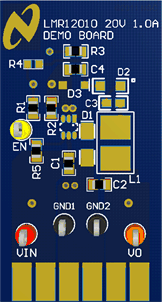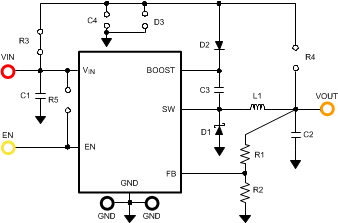SNVA490B September 2011 – December 2021 LMR12010
4 Adjusting the Output Voltage
The output voltage can be changed from 1.8V to another voltage by adjusting the feedback resistors using Equation 1:
Equation 1. VOUT = VFB(1
+ (RFBT / RFBB))
where
- VFB is 0.8 V.
For more information on component selection and features, see the device-specific data sheet.
 Figure 4-1 LMR12010 Demo Board Top
View
Figure 4-1 LMR12010 Demo Board Top
View Figure 4-2 LMR12010 Demo Board Bottom
View
Figure 4-2 LMR12010 Demo Board Bottom
View Figure 4-3 LMR12010Y Demo Board
Schematic
Figure 4-3 LMR12010Y Demo Board
SchematicTable 4-1 Bill of Materials (BOM) for
LMR12010Y
| Part ID | Part Value | Manufacturer | Part Number | Package Type |
|---|---|---|---|---|
| U1 | 1-A Buck Regulator | Texas Instruments | LMR12010 | Thin SOT23-6 |
| C1, Input Cap | 10 µF, 10 V, X5R | Murata | GRM316R61A475KE19D | 1206 |
| C2, Output Cap | 10 µF, 6.3 V, X5R | Murata | GRM319R60J106KE01D | 1206 |
| C3, Boost Cap | 0.01 µF | Vishay | VJ0805Y103KXAAC | 0805 |
| D1, Catch Diode | 0.45 Vf Schottky 1 A, 20VR | Vishay | MBRA120TRPBF | SMA |
| D2, Boost Diode | 1 Vf at 50-mA Diode | Diodes, Inc. | 1N4148W-7-F | SOD-123 |
| L1 | 2.7 µH, 1.8 A, 33 mΩ | TDK | VLCF5028T-2R7N1R8-2 | 6028 |
| R1 | 12.4 kΩ, 1% | Vishay | CRCW080512K4FKEA | 0805 |
| R2 | 10 kΩ, 1% | Vishay | CRCW080510K0FKEA | 0805 |
| R3 | 0 Ω | Vishay | CRCW08050000Z0EA | 0805 |
| D3, C4, R4, R5 | Open |